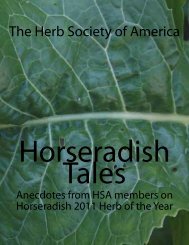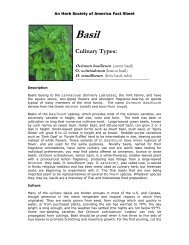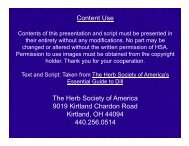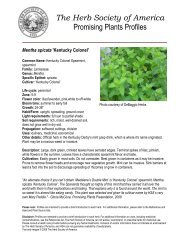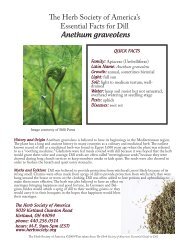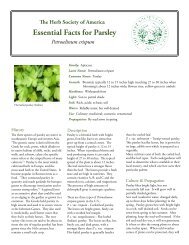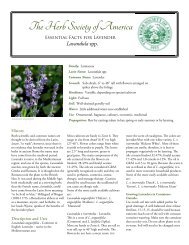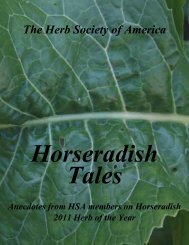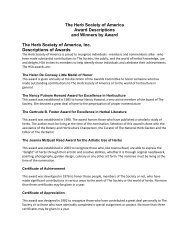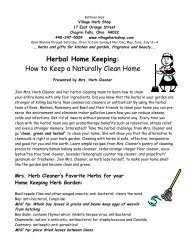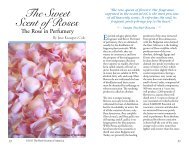The Beginner´s Herb Garden - The Herb Society of America
The Beginner´s Herb Garden - The Herb Society of America
The Beginner´s Herb Garden - The Herb Society of America
Create successful ePaper yourself
Turn your PDF publications into a flip-book with our unique Google optimized e-Paper software.
<strong>The</strong> <strong>Herb</strong> <strong>Society</strong> <strong>of</strong> <strong>America</strong>’s<br />
Essential Guide to<br />
<strong>The</strong> <strong>Beginner´s</strong><br />
<strong>Herb</strong> <strong>Garden</strong><br />
fourth edition<br />
Return to Table <strong>of</strong> Contents<br />
1
"<strong>Herb</strong>s are defined as plants<br />
(trees, shrubs, vines, perennials,<br />
biennials or annuals) valued<br />
historically, presently, or<br />
potentially for their flavor,<br />
fragrance, medicinal qualities,<br />
insecticidal qualities, economic<br />
or industrial use, or in the case<br />
<strong>of</strong> dyes, for the coloring material<br />
they provide."<br />
Holly Shimizu<br />
2 ©2010 <strong>The</strong> <strong>Herb</strong> <strong>Society</strong> <strong>of</strong> <strong>America</strong>
Contents<br />
4 Introduction<br />
5 Cultivation & propagation<br />
Climate ....................................... 5<br />
Soil ............................................. 6<br />
Making Compost ........................ 7<br />
Mulching .................................... 7<br />
Fertilizing .................................... 8<br />
Watering .................................... 8<br />
Staking ...................................... 8<br />
Weeding .................................... 9<br />
Propagation ............................... 9<br />
<strong>Garden</strong> Plans ............................ 11<br />
11 <strong>Garden</strong> design<br />
<strong>Garden</strong> Site ............................... 12<br />
Choice <strong>of</strong> Plants ........................ 12<br />
Selection and<br />
Sources <strong>of</strong> Plants ...................... 13<br />
<strong>Garden</strong> Tools ........................ 15<br />
16 <strong>Garden</strong> maintenance<br />
Pruning & Harvesting .................. 16<br />
<strong>Garden</strong> Cleanup .......................... 16<br />
Winter Protection ......................... 17<br />
18 <strong>Herb</strong>s in Common Use<br />
26 Plant Lists<br />
32 Resources for Beginners<br />
Books ....................................... 32<br />
Websites .................................... 35<br />
Contributors and<br />
Acknowledgements .................. 40<br />
Return to Table <strong>of</strong> Contents<br />
3
Introduction<br />
Not difficult to plan, not at all difficult to maintain, a garden <strong>of</strong><br />
herbs gives more months <strong>of</strong> garden pleasure and more kinds<br />
<strong>of</strong> pleasure than any other. Its interest is independent <strong>of</strong><br />
flowers, its fragrances are given from the first leaf to the last,<br />
its uses make it a part <strong>of</strong> the amenities <strong>of</strong> the whole year,<br />
and its history and traditions touch all nations and all times.<br />
Henry Beston *<br />
<strong>Herb</strong>s have great appeal, for they are practical plants with a<br />
variety <strong>of</strong> uses. Good cooks recognize the extra something<br />
that herbs add to a dish, and others enjoy their fragrance in<br />
potpourris and wreaths. Using herbs <strong>of</strong>ten leads to the desire<br />
to grow them and greatly enhances the intrinsic enjoyment <strong>of</strong><br />
the plants themselves.<br />
As part <strong>of</strong> the whole agricultural scheme, herbs share a<br />
common background with other plants, and therefore similar<br />
garden practices apply. Like all plants, herbs adapt to<br />
varying conditions but will reach their full potential when their<br />
specific needs are met. <strong>The</strong>se needs are briefly discussed in<br />
this guide.<br />
* Beston, Henry. <strong>Herb</strong>s and the Earth. New York: Doubleday,<br />
Doran & Company, 1935.<br />
4 ©2010 <strong>The</strong> <strong>Herb</strong> <strong>Society</strong> <strong>of</strong> <strong>America</strong>
Climate<br />
Cultivation &<br />
propagation<br />
<strong>The</strong> United States is divided by the United States<br />
Department <strong>of</strong> Agriculture (USDA) into various climatic<br />
zones. A state may be entirely in one zone or in several<br />
zones. <strong>The</strong>se zones indicate the average minimum<br />
temperatures in each region and thus relate to the winter<br />
hardiness <strong>of</strong> plants. <strong>The</strong> length <strong>of</strong> the growing season is<br />
defined by the last frost in the spring and the first one in the<br />
fall.<br />
It is important to recognize the characteristics <strong>of</strong> your zone<br />
and select herb plants accordingly. Zones should be used as<br />
a guideline, but should not be regarded as absolute. Small<br />
"microclimates" can exist in protected locations, such as the<br />
south side <strong>of</strong> a house, and extra care can be given to winter<br />
protection, which may allow you to grow some plants outside<br />
<strong>of</strong> your zone. Also, the USDA hardiness zones only refer<br />
to minimum temperatures, not maximum. A plant perfectly<br />
hardy to -10°F may languish in 90°F summer heat and<br />
humidity.<br />
<strong>The</strong> <strong>America</strong>n Horticultural <strong>Society</strong> heat-zone map gives the<br />
average <strong>of</strong> the number <strong>of</strong> days over 86°F. Microclimates can<br />
exist within these zones as well, with shady spots providing<br />
cooler temperatures and sunny spots providing warmer<br />
temperatures.<br />
See the Resources for Beginners section for links to the<br />
Hardiness Zone and Heat Zone maps.<br />
Return to Table <strong>of</strong> Contents<br />
5
Soil<br />
Soil is the natural source <strong>of</strong> all the nutrients needed to<br />
sustain plant growth. <strong>The</strong>re is a direct correlation between<br />
the quality <strong>of</strong> the soil and the health <strong>of</strong> the plant. A good<br />
loamy soil is a combination <strong>of</strong> clay, organic matter, silt and<br />
sand. It contains suitable quantities <strong>of</strong> nitrogen, phosphorous<br />
and potash, as well as the<br />
trace elements necessary to<br />
promote good growth.<br />
Many <strong>of</strong> the more common<br />
herbs are natives <strong>of</strong> the dry,<br />
sunny Mediterranean region<br />
and require the same gritty soil<br />
and excellent drainage. <strong>The</strong><br />
pH factor <strong>of</strong> the soil is equally<br />
important. A soil too acid or too<br />
alkaline hampers vital nutrients<br />
from reaching the plant. Most<br />
herbs prefer an almost neutral<br />
soil with a pH <strong>of</strong> 6.5 to 7.5.<br />
<strong>The</strong> pH can be determined by<br />
a soil test, which may be done<br />
by a county agent or by the<br />
gardener himself with a simple<br />
soil testing kit. Agricultural lime<br />
should be added if the pH falls<br />
below 6.5. Sulfur should be<br />
added if the pH is higher than<br />
7.3.<br />
Testing Soil<br />
Drainage<br />
1. Dig a hole in<br />
the garden about<br />
the size <strong>of</strong> a<br />
gallon jug.<br />
2. Fill the hole<br />
with water and let<br />
it drain. As soon<br />
as the water<br />
has completely<br />
drained,<br />
immediately<br />
fill it again and<br />
keep track <strong>of</strong><br />
how much time<br />
it takes to drain.<br />
If it takes more<br />
than 8 hours, you<br />
need to improve<br />
the drainage.<br />
A heavy clay soil can be<br />
improved with the addition<br />
<strong>of</strong> coarse sand and organic<br />
matter in the form <strong>of</strong> compost, peat moss, leaf humus or<br />
6 ©2010 <strong>The</strong> <strong>Herb</strong> <strong>Society</strong> <strong>of</strong> <strong>America</strong>
well-aged animal manure such as chicken or cow. <strong>The</strong><br />
importance <strong>of</strong> organic material cannot be overstressed. It<br />
gives the soil friability and is essential to seedlings and<br />
young plants. Its addition to loose, sandy soil has a binding<br />
affect that retards excessive percolation. If mixed into<br />
heavier soils, organic matter leaves pores in the soil as it<br />
decomposes, allowing more air to reach the roots <strong>of</strong> the<br />
plants. In areas with frequent rainfall, adding more gritty<br />
material such as sand or oyster shells will increase drainage.<br />
A good garden soil contains nearly 25% air and 25% water.<br />
Making Compost<br />
Compost can be used to enrich the soil organically. With<br />
the ecological emphasis on recycling, there is no better<br />
way to utilize your yard and kitchen waste (excluding meats<br />
and fats) than to include a composting area in your yard<br />
where you can produce your own “black gold.” Call your<br />
local agricultural extension <strong>of</strong>fice for complete plans and<br />
directions for composting or select any <strong>of</strong> several books<br />
available on the subject.<br />
Mulching<br />
A 3 to 4-inch layer <strong>of</strong> mulch can minimize the need for<br />
cultivation and weeding. It will also help slow moisture loss<br />
and thus reduce the need for watering. Mulching material<br />
can be composted wood chips, bark, gravel, sand, shredded<br />
newspapers (without the colored sections), or compost. Be<br />
Return to Table <strong>of</strong> Contents<br />
7
sure to leave 1/2 to 1 inch around the crown <strong>of</strong> each plant<br />
free <strong>of</strong> mulch. Mulch against the plant crown or stem can<br />
hold excessive moisture and heat, promoting disease and/or<br />
rot.<br />
Fertilizing<br />
In general, herbs require only a limited amount <strong>of</strong> fertilizer.<br />
Too much fertilizer encourages leafy growth at the expense<br />
<strong>of</strong> the volatile oil that gives the herb plant its distinction and<br />
flavor.<br />
Watering<br />
Most herbs require an adequate amount <strong>of</strong> water. If the rainfall<br />
is insufficient, water must be supplied. Soak the garden<br />
periodically and avoid frequent light sprinklings which draw<br />
the roots to the surface. While an overhead sprinkler is by<br />
far the most common method <strong>of</strong> watering, a soaker hose (a<br />
hose with tiny perforations along the length) or drip irrigation<br />
system drastically reduce water loss through evaporation<br />
and run<strong>of</strong>f. <strong>Garden</strong> plants on average require about one inch<br />
<strong>of</strong> water per week. Actively growing plants need more moisture<br />
than those which are dormant or resting. If conditions<br />
are hot and dry, more frequent watering may be needed. A<br />
garden with sandy soil will require more water than one with<br />
heavier soil. It is important to know the individual needs <strong>of</strong><br />
each species as well, since some prefer drier conditions than<br />
others.<br />
Staking<br />
Some plant stems are rigid, but others need assistance to<br />
help them stand erect. When using supports, always keep<br />
them as inconspicuous as possible.<br />
8 ©2010 <strong>The</strong> <strong>Herb</strong> <strong>Society</strong> <strong>of</strong> <strong>America</strong>
Various sizes <strong>of</strong> stakes are needed for the average herb<br />
garden. Use several for a large plant, tying a part <strong>of</strong> it<br />
to each stake with green tape or raffia. A loose herb like<br />
Artemisia lactiflora may need a ring and stake combination.<br />
Other useful reinforcements are small branches and different<br />
sizes <strong>of</strong> bamboo. <strong>The</strong> least conspicuous method is a metal<br />
ring with a grid inside, supported by three stakes (these are<br />
available in local garden stores and mail-order catalogs).<br />
<strong>The</strong> plant grows through the grid, eventually covering it<br />
completely.<br />
It is better and easier to place the staking system before the<br />
plant becomes too tall. This way, the plant can grow into it<br />
more naturally and with only occasional guidance from you.<br />
Weeding<br />
Weeds not only detract from the appearance <strong>of</strong> the garden<br />
but compete with the herb plants for moisture and nutrients<br />
in the soil. <strong>The</strong>y can be annual, perennial, or biennial, and<br />
some are prolific seed producers. Keep the weeds pulled<br />
and never let them flower.<br />
Return to Table <strong>of</strong> Contents<br />
Propagation<br />
<strong>Herb</strong>s may be propagated<br />
from seeds, cuttings,<br />
division or layering.<br />
Seeds may be started<br />
outdoors when the soil<br />
has become warm, or they<br />
may be started indoors<br />
six weeks before planting<br />
time in a tray containing a<br />
prepared mixture. When<br />
9
seeds planted indoors have<br />
developed two pairs <strong>of</strong> true<br />
leaves, transplant them to<br />
individual containers. Place<br />
them in a cold frame or<br />
protected area to let them<br />
become accustomed to cooler<br />
temperatures.<br />
Plant seedlings in the garden<br />
when all danger <strong>of</strong> frost is<br />
past and the soil passes the<br />
“clutch test.” If a handful <strong>of</strong><br />
soil crumbles easily, it is ready<br />
to accept plants. If it stays in<br />
a lump, planting should be<br />
delayed.<br />
<strong>Herb</strong>s can be reproduced<br />
by cuttings. Choose sturdy<br />
stems three or four inches<br />
long, and cut them just below<br />
a node. (A node is the swollen<br />
area on the stem from which<br />
the leaves and axillary buds<br />
develop. If the node is inserted<br />
into soil, roots can emerge<br />
from it also.) After removing<br />
the lower leaves, insert the<br />
stems in a pot or flat <strong>of</strong> moist<br />
vermiculite and perlite. Firm<br />
the medium around the<br />
cuttings, set them in the shade, and keep<br />
them moist. <strong>The</strong> use <strong>of</strong> a rooting hormone<br />
may speed the formation <strong>of</strong> roots but is not<br />
essential to successful propagation.<br />
10 ©2010 <strong>The</strong> <strong>Herb</strong> <strong>Society</strong> <strong>of</strong> <strong>America</strong>
If used, follow the manufacturer's directions. When the<br />
plants are well rooted, transfer them to small pots <strong>of</strong> good<br />
friable soil. Perennials may be propagated by division after 2<br />
or 3 years <strong>of</strong> growth. Large clumps may need to be divided<br />
and the pieces replanted. Discard woody stems and roots<br />
that are too old.<br />
Layering is done at any time during the growing season.<br />
Bend a healthy, young, low-growing stem to the ground, and<br />
anchor it with soil or a stone to keep it down. A clothespin<br />
or hairpin can also be used. After new roots develop at the<br />
anchored area, cut the new plant from its parent. One way to<br />
layer semi-woody herbs such as thyme, lavender and winter<br />
savory is to mound soil over the plant interior, leaving the<br />
ends <strong>of</strong> the stems out. Kept this way from fall to spring,<br />
most <strong>of</strong> the stems will have formed roots and can be cut<br />
from the parent plant and set out individually. This can be a<br />
less expensive way to get a large number <strong>of</strong> plants such as<br />
are needed for a knot garden plan.<br />
<strong>Garden</strong> design<br />
<strong>Garden</strong> Plans<br />
<strong>The</strong> size and type <strong>of</strong> garden depends on personal interest,<br />
time, space and family needs. It is wise to start in a modest<br />
way and increase the scope as inclination and experience<br />
dictate. An herb garden may be informal with a mixture<br />
<strong>of</strong> herbs, flowers and vegetables, or it may be formal with<br />
paths and herb beds laid out in simple or complex patterns.<br />
Paths or walks can be made <strong>of</strong> a number <strong>of</strong> materials, such<br />
as brick, stone, gravel, wood chips or grass, but in each<br />
case they should be wide enough to accommodate a garden<br />
cart or mower. For persons with limited space, herbs grown<br />
in a variety <strong>of</strong> containers make an attractive display on a<br />
balcony, walk or patio.<br />
Return to Table <strong>of</strong> Contents<br />
11
<strong>Garden</strong> Site<br />
Choose an area for growing herbs on which the sun shines<br />
four to six hours or more per day. <strong>The</strong> afternoon sun is<br />
strongest and is preferable in northern climates. In the<br />
South, herbs benefit from some shade in the afternoon.<br />
However, if you have a shady yard there are a number <strong>of</strong><br />
herbs that will do well for you. (See the <strong>Herb</strong>s for Shade list.)<br />
<strong>The</strong> site must be well drained. If water remains on top <strong>of</strong> the<br />
soil, drainage is poor and herb growth will be unsatisfactory.<br />
If a badly drained site is the only one available, tiling may<br />
be installed, or, less expensively, raised beds may be<br />
constructed. Raised beds can be built with extra soil kept in<br />
place by raised bed<br />
edgings <strong>of</strong> brick, stone or landscape timbers. A mounded<br />
bed does not require an edging at all, however, this look is<br />
more appropriate in an informal plan. Adding a great deal <strong>of</strong><br />
organic matter to the top two feet <strong>of</strong> soil can also improve<br />
drainage in heavy clay soils.<br />
Choice <strong>of</strong> Plants<br />
Although an herb may be a tree, shrub, vine, or bulb, most<br />
herbs are herbaceous (non-woody) in character. Some<br />
herbs, such as lavender, rosemary and hyssop, may become<br />
semi-shrubs with woody stems, especially in temperate<br />
zones.<br />
Like other plants, herbs classified as annuals have but one<br />
season <strong>of</strong> growth, though some <strong>of</strong> them reseed. Biennials<br />
have two seasons <strong>of</strong> growth, producing leaves the first<br />
year and flowering and setting seed the second year. Most<br />
biennials will reseed themselves, so by planting them two<br />
years consecutively, you should have some plants producing<br />
leaves for harvest and others flowering and reseeding<br />
12 ©2010 <strong>The</strong> <strong>Herb</strong> <strong>Society</strong> <strong>of</strong> <strong>America</strong>
themselves for next year’s foliage crop. Biennial herbs<br />
include some species <strong>of</strong> Digitalis (foxglove), Carum carvi<br />
(caraway) and Petroselinum (parsley). Perennials have<br />
ongoing growth, some <strong>of</strong> them lasting several seasons,<br />
others many years. In colder areas, perennials may die back<br />
completely to the ground in winter and re-emerge from the<br />
crown. Don’t be hasty to remove perennials as some are<br />
slow to show new growth in the spring.<br />
Selection and Sources <strong>of</strong> Plants<br />
Because a garden is a very personal endeavor, the selection<br />
<strong>of</strong> plants is a matter <strong>of</strong> individual preference. <strong>The</strong> type <strong>of</strong><br />
garden decided upon also affects the choice, which will<br />
be further influenced by the suitability <strong>of</strong> plants to the site,<br />
such as height and tolerance <strong>of</strong> shade. (See the <strong>Herb</strong>s In<br />
Common Use section.) Plant gifts from friends may be very<br />
welcome, but remember the gardening adage, “If it’s given to<br />
you, it probably spreads.” Be sure to ask about growth habits<br />
and special care needed.<br />
Return to Table <strong>of</strong> Contents<br />
13
Nomenclature Categories<br />
Salvia <strong>of</strong>ficinalis ‘Tricolor’<br />
Salvia Genus<br />
<strong>of</strong>ficinalis Specific epithet<br />
‘Tricolor’ Cultivar<br />
Petroselinum crispum var. neopolitanum<br />
Petroselinum - Genus<br />
crispum - Specific ephithet<br />
neopolitanum - variety<br />
Become accustomed from the beginning to the botanical,<br />
or Latin, names for herbs. <strong>The</strong>se constitute a nomenclature<br />
used worldwide to avoid confusion and to assure the<br />
accurate identification <strong>of</strong> every plant. Each plant belongs<br />
to a family, and within the family each plant has a name<br />
identifying the genus, the specific epithet and sometimes its<br />
variety or cultivar. Together, the genus name and the specific<br />
epithet describe the species. For example, Salvia is the<br />
genus name for sage. When garden sage is desired, one<br />
must add the specific epithet to that <strong>of</strong> the genus and ask for<br />
Salvia <strong>of</strong>ficinalis. In the same manner, if one wishes to have<br />
clary sage, the most accurate way to refer to it is by its Latin<br />
name, Salvia sclarea. A variety is a naturally-occuring further<br />
subdivision <strong>of</strong> a species, such as Petroselinum crispum<br />
var. neopolitanum. A cultivar is a man-made selection <strong>of</strong> a<br />
species, as in Salvia <strong>of</strong>ficinalis ‘Tricolor.’<br />
Good garden catalogs list herbs by their botanical names<br />
and are valuable sources <strong>of</strong> information on height, color<br />
14 ©2010 <strong>The</strong> <strong>Herb</strong> <strong>Society</strong> <strong>of</strong> <strong>America</strong>
and season <strong>of</strong> bloom. Local nurseries can usually provide<br />
the largest plants. Mail order nurseries can <strong>of</strong>fer plants not<br />
available locally. Keep track <strong>of</strong> your plants with labels, or if<br />
you do not want labels in the garden, do a sketch showing<br />
the names and locations <strong>of</strong> the plants for future reference.<br />
<strong>Garden</strong> Tools<br />
<strong>The</strong> enjoyment <strong>of</strong> working in an herb garden depends in part<br />
upon using the right tools. Select only those that are strong<br />
and durable enough for long years <strong>of</strong> service and take good<br />
care <strong>of</strong> them, keeping them in a convenient area ready for<br />
use.<br />
<strong>The</strong> tools and supplies most <strong>of</strong>ten used in a modest garden<br />
are: spade, spading fork, rake, trowel, hand weeder,<br />
cultivator, pruning shears, scissors, watering can, raffia or<br />
tape, plant stakes, and a hose.<br />
<strong>The</strong> minimum needed is a good pair <strong>of</strong> pruning shears, a<br />
sturdy trowel, watering can or hose and a spade. It is better<br />
to buy less and get the best quality you can afford. Other<br />
tools that may later become necessary are a wheelbarrow<br />
or garden cart, long-handled cultivator, transplanting spade,<br />
loppers and even a pruning saw if trees are included in the<br />
garden.<br />
Return to Table <strong>of</strong> Contents<br />
15
<strong>Garden</strong><br />
maintenance<br />
Pruning & Harvesting<br />
Pruning improves the shape <strong>of</strong> herb plants. To do a good job,<br />
use pruners, loppers or a pruning saw, according to the size<br />
<strong>of</strong> the plant. Dead material should always be removed, and a<br />
weak plant should be cut back so that its food and water can<br />
be used to greater advantage.<br />
Harvesting herbs is a form <strong>of</strong> pruning. Take clippings <strong>of</strong> two<br />
or three inches, preserving the shape <strong>of</strong> the plant as much<br />
as possible. <strong>The</strong> volatile oil in the leaves is most potent just<br />
before the plant blooms. Cutting at this time under optimum<br />
conditions will produce the best harvest, although two more<br />
cuttings may <strong>of</strong>ten be taken before the end <strong>of</strong> the growing<br />
season. Harvesting after the dew has dried on a sunny<br />
morning is ideal. Collect the clippings for drying or freezing in<br />
a basket or paper bag, never a plastic one.<br />
<strong>Garden</strong> Cleanup<br />
<strong>The</strong> garden should be kept clean at all times. Constantly<br />
remove dead leaves, spent flower stalks, and dead flowers<br />
(unless you want the plant to go to seed). Decaying plant<br />
matter encourages slugs, insects and disease. <strong>The</strong> flowering<br />
period <strong>of</strong> many plants can be extended considerably if dead<br />
flower heads are faithfully removed. Remove annual herbs at<br />
the end <strong>of</strong> their growing season and collect plant stakes for<br />
another year <strong>of</strong> use.<br />
16 ©2010 <strong>The</strong> <strong>Herb</strong> <strong>Society</strong> <strong>of</strong> <strong>America</strong>
Winter Protection<br />
Fortunately, many plants are hardy and can withstand cold<br />
and snow. Snow itself is a natural and perfect mulch, provided<br />
it is a winter-long covering. In lieu <strong>of</strong> snow, a mulch <strong>of</strong><br />
straw, oak or beech leaves may be applied when the ground<br />
has frozen. If they are available, place small tree branches<br />
over the leaves to hold them in place. Evergreen branches<br />
can add further protection.<br />
A winter mulch helps maintain an even soil temperature and<br />
thus prevents alternate freezing and thawing with its consequent<br />
winter kill. <strong>The</strong> mulch should be removed gradually in<br />
the spring.<br />
Return to Table <strong>of</strong> Contents<br />
17
<strong>Herb</strong>s in<br />
Common Use<br />
Many beginners may want to start their gardens with plants<br />
from a local or out-<strong>of</strong>-town nursery. Beginners with some<br />
experience may wish to experiment by starting plants from<br />
seeds or cuttings. Listed below are some <strong>of</strong> the herbs most<br />
commonly used.<br />
Basil<br />
Chives<br />
BASIL, SWEET<br />
Ocimum basilicum<br />
Description: Annual; height 1-2’. <strong>The</strong><br />
well-known sweet basil is a bushy<br />
plant with green leaves, white<br />
flowers.<br />
Culture: Well-drained, medium-rich<br />
soil in full sun.<br />
Propagation: Seed, cuttings.<br />
Notes: <strong>The</strong>re are many<br />
wonderful varieties <strong>of</strong> basil available.<br />
Those in the “red” group make excellent<br />
herbal vinegars. Try ‘Red Rubin,’<br />
‘Dark Opal,’ or ‘Purple Ruffles.’ <strong>The</strong>y<br />
also add striking foliage color to the<br />
garden.<br />
CHIVES<br />
Allium schoenoprasum<br />
Description: Hardy perennial; height<br />
10-15”. Erect plant with fine green<br />
onion-like leaves. Pompoms <strong>of</strong><br />
lavender flower heads.<br />
18 ©2010 <strong>The</strong> <strong>Herb</strong> <strong>Society</strong> <strong>of</strong> <strong>America</strong>
Culture: Well-drained, medium-rich soil in full sun.<br />
Propagation: Seed, but slow germination. Divided clumps<br />
increase rapidly. Should be divided every two or three years.<br />
Notes: <strong>The</strong> flower head is edible as well as the leaves and<br />
make an attractive addition to herb vinegars and fresh<br />
salads.<br />
DILL<br />
Anethum graveolens<br />
Description: Annual; height 2-3’. Feathery blue-green<br />
foliage, large umbels <strong>of</strong> small yellow flowers.<br />
Culture: Well-drained, medium-rich soil in full sun. Weeding<br />
and cultivating required to produce large plants. Individual<br />
plants may require staking.<br />
Propagation: Seed. Self-sows readily, resists transplanting,<br />
better to sow directly in the garden or start in peat pots, thin<br />
out as necessary.<br />
Notes: Newer varieties have relegated the older form <strong>of</strong> dill<br />
to the vegetable garden where its large and <strong>of</strong>ten ungainly<br />
growth is more in place. <strong>The</strong> newer dills are compact and<br />
leafy, looking much neater in the herb bed. Two good choices<br />
are ‘Bouquet’ and ‘Fernleaf.’<br />
GERANIUM, ROSE<br />
Pelargonium xasperum ‘Rose'<br />
Description: Perennial only in frost-free areas; height 18-<br />
30”. Deeply cut, heart-shaped, scented foliage, small lavender<br />
blossoms.<br />
Culture: Well-drained, medium-rich soil in full sun. Plants<br />
are<br />
<strong>of</strong>ten grown in containers to facilitate bringing them indoors<br />
for the winter months.<br />
Propagation: Cuttings.<br />
Notes: <strong>The</strong>re are many leaf shapes, textures and scents to<br />
Return to Table <strong>of</strong> Contents<br />
19
Lavender<br />
Lemon Balm<br />
(Geranium, Rose cont.)<br />
choose from among the pelargoniums.<br />
All are tender north <strong>of</strong> Zone 10<br />
and do well in containers. <strong>The</strong> rose<br />
geranium is <strong>of</strong>ten the first tried by<br />
beginning herb gardeners.<br />
LAVENDER<br />
Lavandula angustifolia<br />
Description: Hardy perennial; height<br />
2’. Narrow gray-green leaves, sometimes<br />
with bluish-cast, spikes <strong>of</strong><br />
lavender flowers. Once established,<br />
plant becomes woody.<br />
Culture: Well-drained, alkaline sandy<br />
loam in full sun. Prune plants back in<br />
spring.<br />
Propagation: Seed, cuttings - difficult<br />
to root.<br />
Notes: Some varieties feature pink or<br />
white flowers also. Others, such as L.<br />
stoechas (Z.7) and L. dentata (Z.10),<br />
are tender perennials and need to be<br />
indoors for the winter in colder areas.<br />
LEMON BALM<br />
Melissa <strong>of</strong>ficinalis<br />
Description: Hardy perennial; height<br />
1-2’, spreading plant, dark green<br />
wrinkled leaves, small cream-yellow<br />
flowers.<br />
Lovage<br />
Culture: Moist, well-drained, medium-rich<br />
soil in full sun or partial<br />
shade.<br />
20 ©2010 <strong>The</strong> <strong>Herb</strong> <strong>Society</strong> <strong>of</strong> <strong>America</strong>
(Lemon Balm cont.)<br />
Propagation: Seed, cuttings, division.<br />
Notes: A refreshing lemon scent, excellent in teas. It is<br />
important to remove spent flowers, as lemon balm reseeds<br />
readily and may become a nuisance.<br />
LEMON VERBENA<br />
Aloysia citriodora<br />
Description: Tender north <strong>of</strong> Zone 8; height 2-4’. Shrub-like<br />
plant with crisp, light green leaves, small white flowers.<br />
Culture: Well-drained, medium-rich soil in full sun or partial<br />
shade. Often grown in containers.<br />
Propagation: Cuttings—green stems which have begun to<br />
harden seem to root best.<br />
Notes: <strong>The</strong> best herbal lemon —the scent and flavor<br />
strongly persist, even when dried.<br />
LOVAGE<br />
Levisticum <strong>of</strong>ficinale<br />
Description: Hardy perennial; height 3-5’. Dark green, shiny,<br />
celery-like leaves, umbels <strong>of</strong> small greenish- yellow flowers.<br />
Culture: Moist, well-drained, medium-rich soil in full sun or<br />
partial shade.<br />
Propagation: Seed, cuttings.<br />
MARJORAM<br />
Origanum majorana<br />
Description: Tender perennial; height 8-12”. Small graygreen<br />
scented leaves, knotted buds <strong>of</strong> overlapping bracts<br />
with small white flowers.<br />
Culture: Well-drained, medium-rich soil in full sun.<br />
Propagation: Seed, cuttings.<br />
Return to Table <strong>of</strong> Contents<br />
21
Mint<br />
Parsley<br />
Sage<br />
MINT<br />
Mentha spp.<br />
Description: Hardy perennial; height<br />
1-3’. Shade <strong>of</strong> green on leaf and color<br />
<strong>of</strong> stem vary according to species;<br />
flowers are shades <strong>of</strong> white or<br />
lavender.<br />
Culture: Moist, well-drained, medium-rich<br />
soil in partial shade. Spade<br />
spreading roots in spring to control<br />
the plant, or even better, keep in a<br />
large container above ground.<br />
Propagation: Cuttings, division.<br />
Notes: Many mints cross-pollinate,<br />
<strong>of</strong>ten producing seedlings <strong>of</strong> inferior<br />
flavor and scent. Deadhead plants<br />
or remove seedlings to be sure your<br />
plantings stay true to type.<br />
OREGANO, GREEK<br />
Origanum vulgare ssp. hirtum<br />
Description: Hardy perennial; height<br />
2’. Light green oval leaves with<br />
downy underside, white flowers in<br />
terminal clusters<br />
Culture: Well-drained, medium-rich<br />
soil in full sun.<br />
Propagation: Cuttings.<br />
Notes: This variety is the most commonly<br />
used culinary oregano. It is<br />
helpful to pinch and sniff before you<br />
buy to see if you like the flavor. A<br />
number <strong>of</strong> other oreganos are useful<br />
for dried flowers and as ornamentals.<br />
22 ©2010 <strong>The</strong> <strong>Herb</strong> <strong>Society</strong> <strong>of</strong> <strong>America</strong>
PARSLEY<br />
Petroselinum crispum<br />
Description: Annual or biennial; height 8”. Bright green<br />
leaves. Flower stalks appear in spring <strong>of</strong> second season.<br />
Culture: Well-drained, medium-rich soil in full sun.<br />
Propagation: Seed—slow to germinate, resists<br />
transplanting. Sow directly in the ground or in peat pots.<br />
Notes: See Choice <strong>of</strong> Plants section for information on selfperpetuating<br />
planting using biennials. <strong>The</strong> curly parsley is<br />
very attractive; however, the flat-leaf (also called plain and<br />
Italian) has better flavor for culinary use.<br />
ROSEMARY<br />
Rosmarinus <strong>of</strong>ficinalis<br />
Description: Tender perennial; height 1-3’. Dark green,<br />
needle-like leaves, woolly white on underside, small pale<br />
blue flowers.<br />
Culture: Well-drained, medium-rich, alkaline soil in full sun;<br />
<strong>of</strong>ten grown in containers.<br />
Propagation: Seed which is slow to germinate, cuttings.<br />
SAGE<br />
Salvia <strong>of</strong>ficinalis<br />
Description: Hardy perennial; height 18-30." Gray-green oblong<br />
leaves, much-veined surface gives pebbly effect, purple<br />
flowers on whorls in loose spikes.<br />
Culture: Well-drained, medium-rich, alkaline soil in full sun.<br />
Propagation: Seed, cuttings, division.<br />
Notes: <strong>The</strong>re are many annual and perennial salvias, however,<br />
this is the main culinary variety. Two attractive cultivars<br />
are ‘Tricolor’ and ‘Purpurea.’<br />
Return to Table <strong>of</strong> Contents<br />
23
Savory<br />
Thyme<br />
Sweet Woodruff<br />
SALAD BURNET<br />
Poterium sanguisorba<br />
Description: Hardy perennial; height<br />
12-18’." Medium-green serrated<br />
leaves in opposite, rounded leaflets<br />
along a slender stem. Flowers have<br />
pink tufts <strong>of</strong> stigmas and dangling<br />
stamens and no conspicuous petals.<br />
Culture: Dry, sandy loam in full sun<br />
or partial shade.<br />
Propagation: Seed.<br />
Notes: An attractive plant in the garden,<br />
the leaves add a cucumber-like<br />
flavor to salads.<br />
WINTER SAVORY<br />
Satureja montana<br />
Description: Hardy perennial; height<br />
12." Dark green, short oblong leaves,<br />
small white blossoms. Mature plant<br />
is shrub-like.<br />
Culture: Well-drained, medium-rich<br />
soil in full sun. Keep plant clipped to<br />
induce new growth.<br />
Propagation: Seed, cuttings.<br />
TARRAGON, FRENCH<br />
Artemisia drancunculus ‘Sativa’<br />
Description: Hardy perennial; height<br />
18-30." Smooth olive-green, narrow<br />
leaves; bushy plant with slender<br />
24 ©2010 <strong>The</strong> <strong>Herb</strong> <strong>Society</strong> <strong>of</strong> <strong>America</strong>
(Tarragon cont.)<br />
branching shoots. Does not set seed.<br />
Culture: Well-drained, medium-rich soil in full sun; will<br />
tolerate partial shade. In the South, partial shade is essential.<br />
Does not do well in hot, humid climates.<br />
Propagation: Cuttings, division.<br />
THYME<br />
Thymus vulgaris<br />
Description: Hardy perennial; height 8-12." Small green<br />
ovate to elliptic leaves, light pink flowers. Mature plant is<br />
shrub-like with woody stems.<br />
Culture: Light, well-drained alkaline soil in full sun. Raised<br />
beds are advantageous.<br />
Propagation: Seed, cuttings.<br />
Notes: <strong>The</strong>re are many other varieties <strong>of</strong> thyme, including<br />
lemon-scented, creeping groundcovers and those with variegated<br />
foliage. Some are tender perennials.<br />
WOODRUFF, SWEET<br />
Galium odoratum<br />
Description: Hardy perennial; height 8-10." Stiff whorls <strong>of</strong><br />
glossy medium-green, lanceolate leaves. Stems square,<br />
brittle, slightly hairy. Small, pure white, star-like flowers.<br />
Culture: Well-drained, rich soil in partial shade.<br />
Propagation: Cuttings, division.<br />
Annuals<br />
Return to Table <strong>of</strong> Contents<br />
25
Basil .......................Ocimum basilicum<br />
Borage ...................Borago <strong>of</strong>ficinalis<br />
Chervil ...................Anthriscus cerefolium<br />
Dill .........................Anethum graveolens<br />
Marigold, dwarf .....Tagetes tenuifolia<br />
Marjoram, sweet ...Origanum majorana<br />
Nasturtium ............Tropaeolum majus<br />
Savory, summer ....Satureja hortensis<br />
Biennials<br />
Foxglove ............. Digitalis purpurea<br />
Parsley, curly ...... Petroselinum crispum<br />
Sage, clary ..........Salvia sclarea<br />
Perennials<br />
Plant Lists<br />
26 ©2010 <strong>The</strong> <strong>Herb</strong> <strong>Society</strong> <strong>of</strong> <strong>America</strong>
Artemisia, Wormwood ..Artemisia spp.<br />
Bay ...............................Laurus nobilis *<br />
Bee balm ......................Monarda didyma<br />
Boxwood ......................Buxus spp.<br />
Burnet, salad ................Poterium sanguisorba<br />
Chives ..........................Allium schoenoprasum<br />
Clove pink .................. Dianthus caryophyllus<br />
Comfrey .................... Symphytum <strong>of</strong>ficinale<br />
Garlic ........................ Allium sativum<br />
Geranium, scented ..... Pelargonium (tender north <strong>of</strong> Z.10)<br />
Germander ................ Teucrium chamaedrys<br />
Heliotrope .................. Heliotropium arborescens *<br />
Horseradish ............... Armoracia rusticana<br />
Hyssop ..................... Hyssopus <strong>of</strong>ficinalis<br />
Lavender cotton ..........Santolina chamaecyparissus<br />
Lemon verbena .......... Aloysia citriodora *<br />
Mint ............... ........... Mentha spp.<br />
Oregano, Greek ......... Origanum vulgare ssp. hirtum<br />
Rose, historic ............ Rosa spp.<br />
Rosemary ................. Rosmarinus <strong>of</strong>ficinalis *<br />
Sage, garden ............. Salvia <strong>of</strong>ficinalis<br />
Sage, pineapple ......... Salvia elegans<br />
Savory, winter ............ Satureja montana<br />
Tarragon, French ........ Artemisia dracunculus ‘Sativa’<br />
Thyme ....................... Thymus spp.<br />
Valerian ..................... Valeriana <strong>of</strong>ficinalis<br />
Woodruff, sweet ..........Galium odoratum<br />
Yarrow ............... ........ Achillea spp.<br />
* Tender perennials, not usually hardy north <strong>of</strong> Zone 8<br />
Tall Plants (over 3’)<br />
Bay ..............................Laurus nobilis<br />
Bee balm .....................Monarda didyma<br />
Comfrey ......................Symphytum <strong>of</strong>ficinale<br />
Dill ...............................Anethum graveolens<br />
Return to Table <strong>of</strong> Contents<br />
27
Fennel ............................ Foeniculum vulgare<br />
Foxglove ....................... Digitalis purpurea<br />
Lovage .......................... Levisticum <strong>of</strong>ficinale<br />
Rose, historic ................. Rosa spp.<br />
Sage, clary ..................... Salvia sclarea<br />
Sage, pineapple ............. Salvia elegans<br />
Southernwood ................ Artemisia abrotanum<br />
Valerian ......................... Valeriana <strong>of</strong>ficinalis<br />
Yarrow ............................ Achillea spp.<br />
Medium Plants (18-3”)<br />
Artemisia, Wormwood... Artemisia spp.<br />
Basil ............................. Ocimum basilicum<br />
Borage .......................... Borago <strong>of</strong>ficinalis<br />
Burnet, salad ................ Poterium sanguisorba<br />
Dill, some varieties ....... Anethum graveolens<br />
Geranium, scented ....... Pelargonium spp.<br />
Heliotrope ..................... Heliotropium arborescens<br />
Horseradish .................. Armoracia rusticana<br />
Lady’s mantle ............... Alchemilla vulgaris<br />
Lavender ...................... Lavandula spp.<br />
Lemon balm ................. Melissa <strong>of</strong>ficinalis<br />
Lemon verbena ............ Aloysia citriodora<br />
Mint .............................. Mentha spp.<br />
Marigold, pot ................ Calendula <strong>of</strong>ficinalis<br />
Rosemary .................... Rosmarinus <strong>of</strong>ficinalis<br />
Sage, garden ............... Salvia <strong>of</strong>ficinalis<br />
Savory, summer ........... Satureja hortensis<br />
Savory, winter .............. Satureja montana<br />
Low Plants (Under 18’’)<br />
Boxwood ................. Buxus sempervirens ‘Vardar Valley’ *<br />
Chervil ..................... Anthriscus cerefolium<br />
Chives ..................... Allium schoenoprasum<br />
28 ©2010 <strong>The</strong> <strong>Herb</strong> <strong>Society</strong> <strong>of</strong> <strong>America</strong>
Clove pink. ........................ Dianthus sp.<br />
Garlic ............................... Allium sativum<br />
Germander ....................... Teucrium chamaedrys<br />
Hyssop ............................. Hyssopus <strong>of</strong>ficinalis *<br />
Lavender cotton ............... Santolina chamaecyparissus<br />
Marigold, dwarf ................ Tagetes tenuifolia<br />
Marjoram, sweet .............. Origanum majorana<br />
Nasturtium ....................... Tropaeolum majus<br />
Oregano, Greek ............... Origanum vulgare ssp. hirtum<br />
Parsley ............................ Petroselinum crispum<br />
Thyme ............................. Thymus spp.<br />
Woodruff, sweet .............. Galium odoratum<br />
Wormwood, Roman ........ Artemisia pontica<br />
* clipped<br />
Culinary <strong>Herb</strong>s<br />
Basil ..................................Ocimum basilicum<br />
Bay ....................................Laurus nobilis<br />
Burnet, salad ....... Poterium sanguisorba<br />
Chervil ................. .............Anthriscus cerefolium<br />
Chives.................. .............Allium schoenoprasum<br />
Dill .................................... Anethum graveolens<br />
Fennel ................. .............Foeniculum vulgare<br />
Return to Table <strong>of</strong> Contents<br />
29
Garlic ..................... Allium sativum<br />
Horseradish ...........Armoracia rusticana<br />
Marjoram, sweet ....Origanum majorana<br />
Mint ........................Mentha spp.<br />
Oregano, Greek .....Origanum vulgare ssp. hirtum<br />
Parsley, curly .........Petroselinum crispum<br />
Parsley, Italian .......Petroselinum crispum var. neopolitanum<br />
Rosemary ............. Rosmarinus <strong>of</strong>ficinalis<br />
Sage, garden ........ Salvia <strong>of</strong>ficinalis<br />
Savory, summer .....Satureja hortensis<br />
Savory, winter ........Satureja montana<br />
Tarragon, French ....Artemisia dracunculus ‘Sativa’<br />
Thyme ....................Thymus spp.<br />
Scented <strong>Herb</strong>s<br />
Bee balm ................Monarda didyma<br />
Clove pink ...............Dianthus sp.<br />
Geranium, scented .Pelargonium spp.<br />
Heliotrope ..............Heliotropium arborescens<br />
Lavender ............... Lavandula spp.<br />
Lavender cotton .... Santolina chamaecyparissus<br />
Lemon balm .......... Melissa <strong>of</strong>ficinalis<br />
Lemon verbena ..... Aloysia citriodora<br />
Rosemary ..............Rosmarinus <strong>of</strong>ficinalis<br />
Rose, historic .........Rosa spp.<br />
Sage, pineapple .....Salvia elegans<br />
Southernwood ........Artemisia abrotanum<br />
Thyme ....................Thymus spp.<br />
Valerian ..................Valeriana <strong>of</strong>ficinalis<br />
Woodruff, sweet .....Galium odoratum<br />
<strong>Herb</strong>s for Edging<br />
Boxwood ................Buxus sempervirens ‘Vardar Valley’<br />
Chives ....................Allium schoenoprasum<br />
30 ©2010 <strong>The</strong> <strong>Herb</strong> <strong>Society</strong> <strong>of</strong> <strong>America</strong>
Germander ....................Teucrium chamaedrys<br />
Hyssop ..........................Hyssopus <strong>of</strong>ficinalis *<br />
Lavender ................ ......Lavandula spp.*<br />
Lavender cotton ............Santolina chamaecyparissus *<br />
Marigold, dwarf .............Tagetes tenuifolia<br />
Marjoram, sweet ...........Origanum majorana<br />
Parsley, curly ................Petroselinum crispum<br />
Savory, winter ...............Satureja montana *<br />
Thyme................ ..........Thymus spp.<br />
Wormwood, Roman ......Artemisia pontica<br />
* clipped<br />
<strong>Herb</strong>s for Shade<br />
Chervil ..................,,,,,,,, Anthriscus cerefolium<br />
Lady’s mantle ................Alchemilla vulgaris<br />
Lemon balm ................. Melissa <strong>of</strong>ficinalis<br />
Mint ............................. .Mentha spp.<br />
Valerian ........................ Valeriana <strong>of</strong>ficinalis<br />
Woodruff, sweet ........... Galium odoratum<br />
Return to Table <strong>of</strong> Contents<br />
31
Resources<br />
for Beginners<br />
All <strong>of</strong> the titles in this list are included in the HSA Library collection.<br />
Items denoted with an * circulate to HSA members.<br />
BOOKS<br />
* Bown, Deni. <strong>The</strong> <strong>Herb</strong> <strong>Society</strong> <strong>of</strong> <strong>America</strong> New<br />
Encyclopedia <strong>of</strong> <strong>Herb</strong>s and <strong>The</strong>ir Uses. New York:<br />
Dorling Kindersley, 2001.<br />
This revised edition <strong>of</strong> Bown’s 1995 classic reference work<br />
covers everything from herb history and mythology to<br />
worldwide uses, cultivation, and herb garden design. <strong>The</strong><br />
“A-Z <strong>of</strong> <strong>Herb</strong>s” includes detailed pr<strong>of</strong>iles <strong>of</strong> more than 1000<br />
herbs with 1500 color photographs, arranged by botanical<br />
name. Also includes bibliography, a list <strong>of</strong> herb gardens,<br />
glossary and common name index. 448 pages<br />
* Gardner, Jo Ann. Living with <strong>Herb</strong>s: A Treasury <strong>of</strong> New<br />
and Useful Plants for the Home and <strong>Garden</strong>. Woodstock,<br />
VT: <strong>The</strong> Countryman Press, 1997.<br />
1 Covers growing, harvesting and using herbs in both the<br />
home and the landscape and includes multi-page portraits<br />
<strong>of</strong> seventy-four herbs, complete with personal anecdotes<br />
from the author, an HSA member. With black and white<br />
photographs, line drawings, resource lists and index. 288<br />
pages<br />
* Hill, Madalene, and Gwen Barclay. Southern <strong>Herb</strong><br />
Growing. Fredericksburg, TX: Shearer Publishing, 1987.<br />
This classic text by former HSA president and award<br />
1<br />
32 ©2010 <strong>The</strong> <strong>Herb</strong> <strong>Society</strong> <strong>of</strong> <strong>America</strong>
winner, Hill and fellow HSA member, Barclay, provides an<br />
introduction to herbs and herb gardening tailored to the<br />
<strong>America</strong>n South with pr<strong>of</strong>iles <strong>of</strong> over 130 plants and a<br />
southern herb selection guide. Also includes guidelines for<br />
cooking with herbs and an extensive selection <strong>of</strong> recipes.<br />
With color photographs and index. 196 pages<br />
Hopkinson, Patricia et al. <strong>The</strong> <strong>America</strong>n <strong>Garden</strong> Guides:<br />
<strong>Herb</strong> <strong>Garden</strong>ing. New York: Pantheon Books, 1994.<br />
Compiled by Cornell Plantations, Univ. <strong>of</strong> California Botanical<br />
<strong>Garden</strong> and Matthaei Botanical <strong>Garden</strong>. Introduction<br />
includes “Botany for <strong>Garden</strong>ers.” “Plant Selector” section<br />
includes listing <strong>of</strong> herbs by use and color, plus color<br />
photographs and portraits <strong>of</strong> more than 200 herbs. Sidebars<br />
cover a variety <strong>of</strong> topics, including Native <strong>America</strong>n uses,<br />
aromatherapy, history and tips. Also includes design guide,<br />
description <strong>of</strong> gardening techniques, and gardening for<br />
special conditions and climates. Includes glossary and index.<br />
223 pages<br />
* McVicar, Jekka. New Book <strong>of</strong> <strong>Herb</strong>s. New York: Dorling<br />
Kindersley, 2002.<br />
This encyclopedic book provides information on growing<br />
herbs organically and using them in cooking as well as for<br />
home cleaning, first aid, beauty, relaxation and pet care.<br />
Also includes pr<strong>of</strong>iles <strong>of</strong> 100 plants with cultivation and use<br />
information. With color photographs, resource list and index.<br />
288 pages<br />
* Michalak, Patricia S. Rodale’s Successful Organic<br />
<strong>Garden</strong>ing: <strong>Herb</strong>s. Emmaus, PA: Rodale Press, 1993.<br />
A concise guide to gardening basics, plant selection,<br />
cultivation and maintenance, preserving, storing and using<br />
herbs. With pr<strong>of</strong>iles and color photographs <strong>of</strong> over ninety<br />
herbs. Includes index. 160 pages<br />
Return to Table <strong>of</strong> Contents<br />
33
* Kowalchik, Claire and William H. Hylton, eds. Rodale’s<br />
Illustrated Encyclopedia <strong>of</strong> <strong>Herb</strong>s. Emmaus, PA: Rodale<br />
Press, 1987.<br />
Entries for each plant range from one to several pages<br />
and include history, uses (medicinal, ornamental, culinary,<br />
cosmetic, dye), description, flowering, range, growing<br />
conditions, cultivation, and folklore. Includes entries on<br />
herbal topics as well as 140+ individual plants. 545 pages<br />
* Shaudys, Phyllis V. <strong>The</strong> Pleasure <strong>of</strong> <strong>Herb</strong>s: A Monthby-Month<br />
Guide to Growing, Using, and Enjoying <strong>Herb</strong>s.<br />
Pownal, VT: Storey Communications, 1986.<br />
Shaudys, an HSA member, devotes a chapter to each month<br />
<strong>of</strong> the year, highlighting an herb for the month and providing<br />
seasonal recipes, garden advice and crafts. Appendices<br />
include “A Brief Encyclopedia <strong>of</strong> <strong>Herb</strong>s,” “Growing Fragrant<br />
<strong>Herb</strong>s for Pr<strong>of</strong>it,” “Directory <strong>of</strong> <strong>Herb</strong> Businesses and<br />
<strong>Garden</strong>s” and a bibliography. Includes black and white<br />
illustrations and index. 275 pages<br />
* Swanson, Faith H. and Virginia B. Rady. <strong>Herb</strong> <strong>Garden</strong><br />
Design. Hanover: University Press <strong>of</strong> New England,<br />
1984.<br />
This classic reference work by two HSA members includes<br />
plans for over fifty types <strong>of</strong> gardens, from basic designs<br />
to historical, specialty, educational and formal gardens.<br />
Each design includes a list <strong>of</strong> plants and full-page design<br />
plan. With index and black and white photographs and<br />
illustrations. 155 pages<br />
* Tucker, Arthur O. and Thomas DeBaggio. <strong>The</strong> Big<br />
Book <strong>of</strong> <strong>Herb</strong>s: A Comprehensive Illustrated Reference<br />
to <strong>Herb</strong>s <strong>of</strong> Flavor and Fragrance. Loveland, CO:<br />
Interweave Press, 2000.<br />
Introductory chapters cover “Plant Identification,”<br />
nomenclature, “Maximizing Flavors and Fragrances,”<br />
“Container Cultivation,” creating the best growing conditions,<br />
34 ©2010 <strong>The</strong> <strong>Herb</strong> <strong>Society</strong> <strong>of</strong> <strong>America</strong>
“Propagation and Planting,” “Keeping <strong>Herb</strong>s Healthy,” and<br />
harvesting. Includes pr<strong>of</strong>iles <strong>of</strong> over 100 herbs. Individual<br />
pr<strong>of</strong>iles include common and botanical name, names in<br />
various languages, family, growth form, hardiness, light,<br />
soil, propagation, uses, chemistry and botanical description.<br />
With black and white line drawings, extensive reference list<br />
and index. An important resource from two <strong>of</strong> HSA’s expert<br />
members. 688 pages.<br />
WEBSITES<br />
Plant Information Online - http://www.plantinfo.umn.edu/<br />
*A useful resource for sources for plants in <strong>America</strong>n nurseries.<br />
Allows you to search for magazine and book citations as<br />
well as plant images.<br />
Henriette’s <strong>Herb</strong>al Homepage<br />
www.henriettesherbal.com<br />
This site from Finnish herbalist, Henriette Kress, includes<br />
culinary and medicinal herbfaqs, the text <strong>of</strong> classic herbal<br />
works now in the public domain, a listing <strong>of</strong> plant names in<br />
various languages and over 9,600 plant images. Note that<br />
the herbfaqs on this site are archived from discussion lists so<br />
not all information may be authoritative.<br />
Montreal Botanic <strong>Garden</strong> Green Pages - <strong>Herb</strong>s Section<br />
www2.ville.montreal.qc.ca/jardin/en/info_verte/fines_herbes/fines_herbes.htm<br />
Includes information on planning, cultivation, harvesting,<br />
pests, drying, storing and indoor growing. Available in French<br />
and English. Also includes book list.<br />
Return to Table <strong>of</strong> Contents<br />
35
<strong>America</strong>n Horticultural <strong>Society</strong><br />
Heat Zone Map<br />
36 ©2010 <strong>The</strong> <strong>Herb</strong> <strong>Society</strong> <strong>of</strong> <strong>America</strong>
<strong>America</strong>n Horticultural <strong>Society</strong> Heat Zone Finder<br />
http://www.ahs.org/publications/heat_zone_map.htm<br />
Return to Table <strong>of</strong> Contents<br />
37
38 ©2010 <strong>The</strong> <strong>Herb</strong> <strong>Society</strong> <strong>of</strong> <strong>America</strong>
For an online, interactive USDA Plant Hardiness Zone Map<br />
go to: http://www.usna.usda.gov/Hardzone/ushzmap.html<br />
This map follows the USDA cold hardiness system which is<br />
based on average mininum temperatures in each area and gives<br />
guidelines for plant adaptability. For a more detailed color<br />
hardiness map, please call the U.S. Printing Office at (202)512-<br />
1800 and refer to stock number 001-000-04550-4.<br />
Return to Table <strong>of</strong> Contents<br />
39
Original text by the<br />
1983 Handbook<br />
Committee:<br />
Eleanor Donley<br />
Blanche Harvey<br />
Elizabeth B. Neavill<br />
Nelle Neff<br />
Jane C. Piwonka,<br />
Chairman<br />
Jean Ruh<br />
Members <strong>of</strong> the<br />
Western Reserve <strong>Herb</strong><br />
<strong>Society</strong><br />
1998 revision by:<br />
Ann S. Lamb<br />
Robin A. Siktberg<br />
Linda M. White<br />
2003 revisions by:<br />
Michele Meyers,<br />
HSA Director <strong>of</strong><br />
Education<br />
Robin Siktberg<br />
HSA Editor/<br />
Horticulturist<br />
Contributors and<br />
Acknowledgements<br />
llustrations by:<br />
Eleanor Donley<br />
Photographs by:<br />
Robin Siktberg<br />
Janeen Wright<br />
Special Thanks to:<br />
Virginia (Ginny) Miller<br />
Elizabeth (Bam) Postell<br />
Arthur 0. Tucker, Ph.D.<br />
Based on <strong>The</strong> Beginner’s <strong>Herb</strong><br />
<strong>Garden</strong>, 2nd Edition<br />
© 1983, 1998, 2003 <strong>The</strong> <strong>Herb</strong><br />
<strong>Society</strong> <strong>of</strong> <strong>America</strong><br />
2010 revisions by:<br />
Janeen Wright<br />
Educator/Horticulturist<br />
Robin Siktberg<br />
HSA Editor/Horticulturist<br />
40 ©2010 <strong>The</strong> <strong>Herb</strong> <strong>Society</strong> <strong>of</strong> <strong>America</strong>




